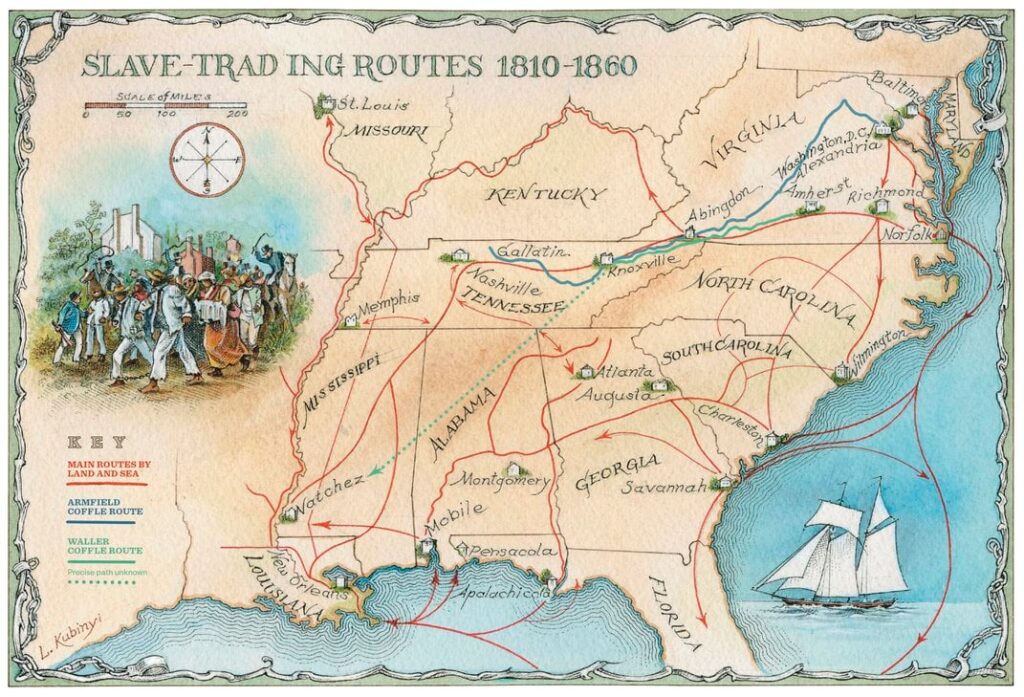I had never heard of the Slave Trail of Tears until recently. I read and research to prepare information for my blog posts. Sometimes, the research leads me down a path of darkness. Many of us are still searching for answers to questions that continue to trouble us. To understand the history of slavery, I read the book, Africans in America, America’s Journey through Slavery. This informative and enlightening book was written by Charles Johnson, Patricia Smith, and the WGBH Series Research Team. Like the authors, I wonder why we should revisit a past that consists of pain, anguish, guilt, and embarrassment. The authors stated the story of slavery is as much as part of who we are as victory in WWII, Union victory in the Civil War, and victory in the American Revolution. We have a history of tragedy and triumph.
In 1607, three vessels manned by 120 colonists landed in a part of Virginia wilderness in a place named Jamestown. The colonists hoped to build the first permanent English settlement in the New World. According to the charter granted by King James, their mission was to “first preach and baptize into the Christian religion.” The settlement of Jamestown was also a business venture. The Virginia Company of London recruited the first group of settlers. They were paid fine precious metals and minerals. The settlers were too lazy to work the land and many died. The Virginia Company wanted a return on their investment. The colonists experimented with tobacco seeds from Trinidad. By 1617, the first shipment of tobacco was sent to England. Plantations sprouted up everywhere. They needed help to work the land. Initially, lower class people from England were brought over as indentured servants. For the next hundred years, between half and two-thirds of white immigrants were brought over as indentured servants. Of the fifteen thousand sent to Virginia during the first fifteen years, only two thousand survived.
In 1619, a Dutch ship robbed a Spanish vessel of twenty Africans. The crew traded them for food and the twenty captives were released to their new owners. Initially, they were put to work as indentured servants. Eventually, the rules changed for indentured servants. At the end of their contracts, many were not renewed. There was still land to work so darker became wrong. Treating black and white people differently made them suspect each other. White people could leave and not be detected. By 1639, if a person didn’t look European or their skin was not white, they could be enslaved. There is a lot of history during those years but you have to research and unearth it. The Slave Trail of Tears is a part of history that was buried, then unearthed.
In 1834, Virginia formed the capital of the Confederacy. Hidden in history were papers about a forced march of enslaved people, chained together in coffle fashion. Richmond was the hub for exporting slaves southward. It took four months to assemble the coffle. Slave dealers like Franklin and Armfield sold more people and made more money. Armfield was based in Virginia and Franklin was in Louisiana. Large wagons were filled with provisions. New clothes for the enslaved people were bundled up and placed in the wagons. They would wear them at the end of the trip so they could dress well for the sale. There was a pair of carriages for the whites. Enslaved men, women, children, and the armed slave holders marched from the Southern tobacco state of Virginia to the cotton states in the South. The march from Virginia to Tennessee took three months. They walked ten hours a day. The goal was to end up in Louisiana. Nashville, Tennessee was considered the half way point.
According to historians, Armfield sat on his horse in front of the human procession, armed with a gun and a whip. Other armed white men were arrayed behind him. They were guarding 200 men and boys lined up in twos, their wrists handcuffed together, a chain running the length of 100 pairs of hands. Behind the men were the women and girls, another hundred. They were not handcuffed, although they may have been tied with rope. Some carried small children. After the women came the big wagons. These carried food, plus children too small to walk ten hours a day. Later the same wagons hauled those who had collapsed and could not be roused with a whip. A clean back was a rarity and raised the price. It meant that an enslaved person was not defiant and sold for a higher price.
The thousand -mile long river of enslaved people were moved from the Upper South to the Deep South. This forced settlement was 20 times larger than Andrew Jackson’s “Trail of Tears.”
Until recently the horrible Slave Trail was buried. The story of enslaved people who walked a thousand miles from the tobacco South to the cotton South vanished. We can’t let our painful history vanish.
Francie Mae. November 29, 2022
References
Johnson, Charles and Smith, Patricia. WGBH Series Research Team. Africans in America. America’s Journey through Slavery.1999. WGBH. Boston, Massachusetts.
Smithsonian Magazine. Secrets of American History. Retracing Slavery’s Trail of Tears. America’s forgotten migration – the journeys of a million African-Americans from the tobacco South to the cotton South. Edward Ball; Photographs by Wayne Lawrence. November 2015.
